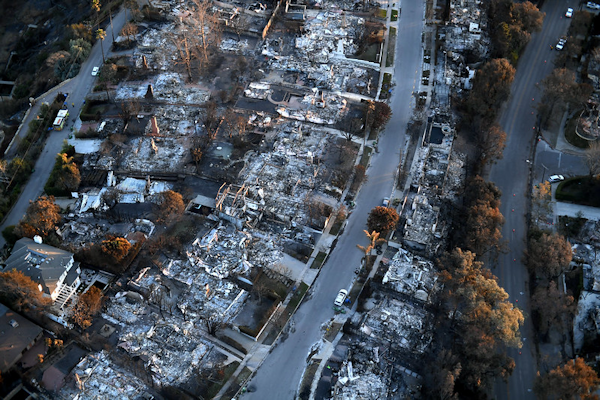SEJournal Online is the digital news magazine of the Society of Environmental Journalists. Learn more about SEJournal Online, including submission, subscription and advertising information.
 |
 |
| Homes burned in fires near Pacific Palisades, California, in January. Insurance experts believe insured losses from the California fires may be more than $40 billion. Photo: U.S. Army/Jon Soucy via Flickr Creative Commons (CC BY 2.0). |
Issue Backgrounder: Insurance Meltdown a Foreseeable Climate Disaster
By Joseph A. Davis
The spate of catastrophic fires in Southern California during January 2025 was worse than anyone could imagine. They have set records for loss, trauma and destruction. The insurance companies are still counting. The politicians are pointing fingers.
 |
The fires were caused by many things: climate change, yes — and also the Santa Ana winds, and more.
As climate change spawns wildfires, hurricanes, floods and other disasters, homeowners insurance is rising in price or even disappearing. What will happen to the housing market?
In the short term, the consequence will be strained budgets. In the longer term, in coming years, it could be financial catastrophe.
Homeowners insurance is going away for some states — specifically because of climate-induced disasters, like flooding. You can’t get a mortgage without homeowners insurance. The threat is that a glut of bad mortgages could cause another nationwide financial crisis.
Outgoing Treasury Secretary Janet Yellen warned of this possibility.
“This ‘protection gap’ may indicate that Americans are facing challenges in finding available and affordable insurance in their area,” Yellen has said. “This can have significant consequences for homeowners and the values of their assets. In turn, these developments can have cascading effects on the financial system.”
Only a few remember the “savings and loan crisis” of 1986-95, which destroyed scores of financial institutions because of bad mortgages. It badly damaged the U.S. economy.
In the financial crisis of 2007-8, mortgage-backed securities and derivatives collapsed in value, causing great hardship to those who lost their homes and nest eggs. One of the initial causes was an accumulation of bad (“subprime”) mortgages from predatory lending. That, and the failure to see the riskiness of the market before it was too late.
Uninsured disasters
It’s bad enough that entire neighborhoods are incinerated in events like California’s Camp Fire of 2018. Or that 2024’s Hurricane Helene caused tens of billions in damage in North Carolina and the Southeast. Disasters of this intensity — worsened by climate change — are way off the chart.
Worse yet: Most of the victims of these disasters were uninsured. Many lost everything.
While authorities are still counting the losses, one thing is already clear. In worst-hit parts of western North Carolina, for instance, estimates of the percentage of victims who had flood insurance range from 1% to 5%.
It turns out that nationwide,
only about 4% of homeowners
have flood insurance.
Shocking but not surprising. It turns out that nationwide, only about 4% of homeowners have flood insurance. Normal homeowners insurance excludes flood risk.
The National Oceanic and Atmospheric Administration estimates that in just the year 2023, damages from billion-dollar extreme weather events were $92.9 billion, and estimated insured property losses totaled $78.8 billion.
Is flood insurance program fixable?
The solution in flood-prone areas is supposed to be the National Flood Insurance Program, which is run by the Federal Emergency Management Agency.
The NFIP is pretty much the only way you can get flood insurance in the U.S. Except the NFIP is bankrupt and hasn’t really worked for years.
The basic deal is that NFIP will back flood insurance in an area if the municipality forbids construction in the flood plain. The NFIP tries to map out the flood plains — except their maps are often incomplete or out of date (ongoing climate change is relentlessly expanding flood-prone areas).
The actual insurance is usually managed by private insurance companies, with guarantees from NFIP as a backup. Theoretically, the NFIP is supposed to be funded by insurance premiums. But current premiums are seldom enough to cover insured losses. So Congress eventually just pays for the huge deficits with emergency supplemental appropriations.
Every time that happens, Congress members make floor speeches about the need for reform. But year after year, Congress kicks the can down the road and avoids reform.
It’s simple politics. The only way to really reform NFIP is to raise premiums paid by insured homeowners to a level that would cover the rising risks. A level most flood-prone homeowners find unaffordable. Real reform, aka higher premiums, would be politically unpopular. So Congress avoids it.
Limits to FEMA aid
What federal help there is comes in the form of “FEMA assistance.” The main thing to understand is that FEMA aid is meant to help people in the immediate crisis when a disaster wrecks their home or displaces them.
That means FEMA might eventually pay for things like medications, diapers, moving and storage expenses, funerals, transportation and temporary housing.
FEMA assistance may cover “home repair” (which might mean replacing windows but not cabinets). But it doesn’t cover rebuilding an entire home.
And, oh, Donald Trump is now threatening to abolish FEMA altogether.
Changing understanding of climate change
Insurers manage risk — with a lot of help from actuaries, who translate the chances of dollar losses into numerical odds insurers can apply. But the whole point of climate change is that the risks themselves are changing.
What was once a 500-year flood may be a 100-year flood today. Climate is changing wildfire and flood risks as well.
More people seem to be moving
and building unfazed into high
fire-risk and flood-risk areas.
They dream of homes
that could be nightmares.
At the same time, more people in the U.S. seem to be moving and building unfazed into high fire-risk and flood-risk areas. They dream of homes that could be nightmares.
The insurance industry often seems to understand the looming crisis. The National Association of Insurance Commissioners last year drew up a “National Climate Resilience Strategy for Insurance.“
But a lot of the mechanisms once meant to locate and quantify these property risks are themselves out of date. Case in point: FEMA-NFIP flood maps. This problem is worsened because people often don’t want their houses remapped into a flood plain.
Who’s to blame?
Scapegoating is human nature, regrettably. “Who’s to blame?” is often a question that brings too-easy answers. Journalists may want to avoid easy answers. In this case, there is plenty of blame to go around.
In media accounts of disasters, it is often the insurance companies who get the blame. The stories get written as soon as rates go up. But it’s not the insurance companies who cause floods and wildfires. Maybe we should ask what insurance companies are investing their vast billions in. Some still invest in oil companies.
In California, it has often come to be the electric power companies that are blamed for fires because of sparks from downed lines. But the power companies don’t make people build in fire-prone areas or build wooden houses. They do, however, have deep enough pockets to pay billions in damages.
It might be fair to blame Congress for lacking the political courage to really fix the NFIP or adopt politically difficult forest management policies. But it may just be that Congress is so closely divided. And state and local governments bear equal blame for bad forest management or poor zoning and building codes.
Or it could be human nature. Climate denial is just one of the ways people avoid uncomfortable truths. That beach house or forest hideaway is just too inviting. It can’t happen here. Really?
Or possibly — almost no one will say this out loud — that many people were not meant to live that densely in a place with so little water.
[Editor’s Note: See our related Reporter’s Toolbox on climate risk data. And for more on the insurance angle, see Tipsheets on property risk disclosure, flood risk for homebuyers, home insurance and climate, wildfire insurance, climate financial risks and climate disaster victims, plus up-to-date headlines on insurance issues. Also, for extensive coverage of climate disaster-related issues, see our Topics on the Beat pages on disasters, climate change, wildfire and hurricanes.]
Joseph A. Davis is a freelance writer/editor in Washington, D.C. who has been writing about the environment since 1976. He writes SEJournal Online's TipSheet, Reporter's Toolbox and Issue Backgrounder, and curates SEJ's weekday news headlines service EJToday and @EJTodayNews. Davis also directs SEJ's Freedom of Information Project and writes the WatchDog opinion column.
* From the weekly news magazine SEJournal Online, Vol. 10, No. 7. Content from each new issue of SEJournal Online is available to the public via the SEJournal Online main page. Subscribe to the e-newsletter here. And see past issues of the SEJournal archived here.












 Advertisement
Advertisement 



